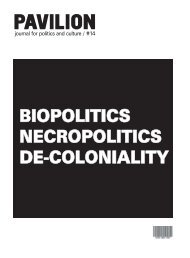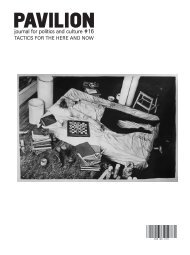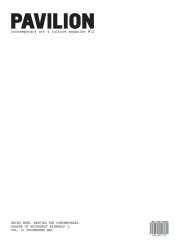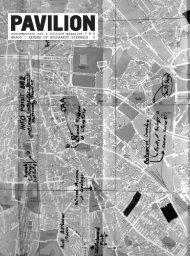PAVILION
PAVILION
PAVILION
- No tags were found...
You also want an ePaper? Increase the reach of your titles
YUMPU automatically turns print PDFs into web optimized ePapers that Google loves.
Christine Meisner<br />
Recovery of an Image/ 4 Instrumente<br />
History does not only deal with a certain past,<br />
but acts itself as a form of narration. Christine<br />
Meisner’s series of works was geworden ist<br />
(what became) informs about the irrecoverableness<br />
of a forced socio-cultural change,<br />
which occurred due to the slave trade between<br />
West-Africa and Brazil. Based on research<br />
trips to Nigeria and Brazil and through interviews<br />
with descendants in direct confrontation<br />
with historical documentalities, Meisner’s work<br />
elaborates - in the form of video, drawings and<br />
texts - on the past’s present and present’s<br />
autonomy detached from history.<br />
The video Recovery of an Image narrates<br />
Joao Esan da Rocha’s life story, who was<br />
deported as a ten year old boy from Lagos to<br />
Salvador de Bahia, Brazil to work as a slave<br />
on a sugar cane plantation. After 31 it became<br />
possible to buy him off and he moved back to<br />
his home country. Although he always wanted<br />
to go back, he would only find his place in<br />
Lagos' Brazilian community. The “Returnees” -<br />
former slaves from Brazil - form their own<br />
secluded world inside of British colony Lagos,<br />
living an absorbed Brazilian culture rather than<br />
their original African culture. Meisner’s video is<br />
a fictional story of historical facts, circling<br />
around issues and processes of memory.<br />
4 Instrumente, a series of drawings, shows<br />
instruments that were used to keep slaves<br />
from running away. The way in which the drawings<br />
depict those tools is fragmentary and isolated,<br />
thus they do not try to illustrate mechanisms<br />
of slavery but rather confront us with a<br />
certain crypticality - an uncertainty to imagine<br />
the tool’s proper function - that hints at more<br />
general issues of non-representability, historical<br />
remembering and the exhibiting of history.<br />
(Felix Vogel)<br />
Recuperarea unei imagini/ 4 instrumente<br />
Istoria nu tratează numai un anumit trecut, dar<br />
acţionează ca o formă de naraţiune. Seria de<br />
lucrări a lui Christine Meisner „was geworden<br />
ist” (ce a devenit) semnalează imposibilitatea<br />
recuperării unei schimbări socio-culturale<br />
forţate, ce a avut loc în urma comerţului cu<br />
sclavi dintre Africa de Vest şi Brazilia. Bazată<br />
pe călătoriile de cercetare în Nigeria şi Brazilia<br />
şi prin interviuri cu descendenţii aflaţi în confruntare<br />
directă cu documentaritatea istorică,<br />
lucrarea lui Meisner elaborează - în forma<br />
video-ului, a desenelor şi a textelor - asupra<br />
prezentului trecutului şi asupra autonomiei<br />
prezentului detaşat de istorie.<br />
Video-ul Recuperarea unei imagini<br />
narează povestea de viaţă a lui Joao Esan da<br />
Rocha, care a fost deportat la zece ani din<br />
Lagos în Salvador de Bahia, Brazilia pentru a<br />
munci ca sclav pe o plantaţie de trestie de<br />
zahăr. După ce a împlinit 31 de ani a putut fi<br />
cumpărat şi s-a întors în ţara sa natală. Deşi a<br />
[458]<br />
vrut întotdeauna să se întoarcă, şi-a găsit locul<br />
doar în comunitatea braziliană din Lagos.<br />
„Reîntorşii” - foştii sclavi din Brazilia - şi-au format<br />
propria lor lume izolată în colonia britanică<br />
Lagos, trăind mai degrabă într-o cultură braziliană<br />
asimilată decât în cultura lor nativă<br />
africană. Video-ul lui Meisner este o istorie<br />
ficţională de fapte istorice, ce tratează problemele<br />
şi procesele memoriei.<br />
4 Instrumente, o serie de desene,<br />
schiţează instrumentele care ajutau la imobilizarea<br />
sclavilor. Modul în care desenele<br />
descriu uneltele este fragmentar şi izolat, de<br />
aceea nu încearcă să ilustreze mecanismele<br />
sclaviei, dar să confrunte privitorul cu o anumită<br />
cripticitate - o nesiguranţă în a imagina<br />
funcţia efectivă a uneltei - care trimite la<br />
chestiuni ce ţin de non-reprezentatibilitate,<br />
rememorare istorică şi expunerea istoriei.<br />
(Felix Vogel)<br />
Christine Meisner: Recovery of an Image, 2005, video, 26'.<br />
Courtesy of the artist.<br />
[459]








